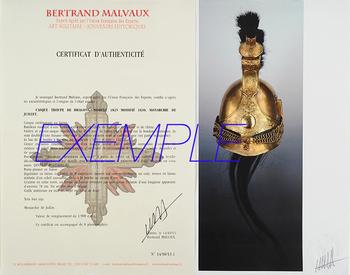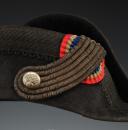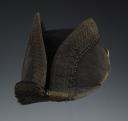
BICORNED HAT OF AN OFFICER OF THE 1st REGIMENT OF CUIRASSIERS OF THE LINE IN SMALL DRESS, Second Empire. 27023
BICORNED HAT OF AN OFFICER OF THE 1st REGIMENT OF CUIRASSIERS OF THE LINE IN SMALL DRESS, Second Empire. 27023
In black “Flemish” felt highlighted with a large braid woven in black wool with sticks with scalloped edges, it is folded astride the exterior parts of the bicorne, H visible on each side 3.9 cm; braid formed of three twists in matte silver, redoubling around a large-module silver metal uniform button stamped with a flaming bomb with the number “1”. Tricolor cockade, diameter 8 cm. Black silk inner headdress and black waxed leather headband. Lining of the cap gilded with gold “BABIN NANCY”.
Length 45 cm, width 18 cm, H 10 cm at the front, H 15 cm at the back.
France.
Second Empire.
Good condition, wear at the ends of the horns and rubbing on the sheet.
HISTORY:
By decree of 1st Vendémiaire Year XII (September 24, 1803) the 1st Cuirassier Regiment was formed from the 1st Cavalry Regiment and also received the 1st and 2nd squadrons of the 24th Cavalry Regiment which had been dissolved.
- Revolution and First Empire
The 1st Cuirassier Regiment left Landau in the year , Eylau and Friedland.
In 1809 he was with the armies of the Rhine and Germany attached to the 3rd cavalry corps with which he fought at Essling and Wagram.
After a year of rest, in Metz, in the reserve corps of the German army, he returned to Germany in 1811 to be part of the Elbe observation corps and marched in Russia in 1812 and distinguished himself at Polotsk, Moskowa and Berezina.
In 1813 and 1814 assigned to the 2nd cavalry corps of the Grande Armée, he garrisoned in Hamburg and participated in the battles of Leipzig and Hanau.
- During the first Restoration, the 1st regiment of Cuirassiers bore the title of Cuirassiers du Roi and regained its initial name upon Napoleon's return from the Island of Elba.
In 1815 assigned to the 1st Cavalry Reserve Division, he made his ninety-fifth and final campaign, fighting furiously at Waterloo. The regiment is made up of 465 men including 43 officers and 422 enlisted men and are integrated into the IVth Cavalry Corps - 13th Cavalry Division - 1st Brigade.
He obscurely ended his glorious career in Loches, where he was dismissed on December 24, 1815, like all French military units, as a simple marching regiment.
1805:
Battle of Wertingen
Battle of Ulm
Hollabrunn Battle
Battle of Raussnitz
December 2: Battle of Austerlitz
1806: Jena and battle of Lübeck, Berlin.
1807:
battle of Hoff
February 8: Battle of Eylau
1809:
Battle of Eckmühl,
capture of Regensburg,
Battle of Essling,
Battle of Wagram,
Hollabrunn,
Battle of Znaim.
1812: Russian campaign
battle of the Moskva,
capture of Moscow
Battle of Winkowo.
1813: German campaign
Battle of Katzbach,
October 16-19: Battle of Leipzig
Battle of Hanau,
Hamburg defense.
1814: French Campaign (1814)
Pavement,
February 14, 1814: Battle of Vauchamps
Bar-sur-Aube,
Sézanne,
Valcourt (Haute-Marne).
1815: Belgian Campaign (1815)
Ligny,
Genappe,
Waterloo.
- Colonels killed or wounded while commanding the 1st Cuirassier regiment.
brigade chief Margaron: Wounded on 27 Thermidor 1799
Colonel Clerc: Wounded October 30, 1813 and March 30, 1814
Colonel Ordener: Wounded June 18, 1815
- Officers killed or wounded while serving in the 1st Cuirassier regiment under the Empire. (1805-1815):
Officers killed: 50
Officers who died from their injuries: 4
Officers injured: 86
- Queen's Cuirassier Regiment
From 1816 to 1831
By royal orders of July 16 and August 30, 1815, some of its remains were poured into the formation of the 2 regiments of Cuirassiers of the Royal Guard and its base entered the composition of the Queen's Cuirassier Regiment, 4th current regiment, which at the same time received the bottom of the 10th regiment of Cuirassiers, ex-Royal-Cravates.
In 1819-1820 the regiment garrisoned in Dijon, in 1823 it was in Toul, in 1824 in Sedan, in 1825 in Nancy, in 1826 in Joigny, in 1827 in Vendôme and in Tours in 1828.
During the revolution of 1830, the regiment was sent to Angers to maintain order there, before garrisoning Vendôme and Meaux in 1830, and Versailles in 1831.
1st Cuirassier Regiment
By order of the King, dated February 19, 1831, the 1st Cuirassier Regiment was formed from the simple renaming of the Queen's Cuirassier Regiment, created in 1815, this name having been suppressed after the revolution of July 1830.
From 1832 to 1852
In 1832, while garrisoned in Lille, he was sent to Belgium as part of the Ten Days campaign.
He was then sent to garrison at Compiègne, Nancy from 1833 to 1836 and Paris in 1837.
From 1838 to 1842, he was stationed in Haguenau then in Vesoul from 1843 to 1848. During the revolution of 1848, the regiment was sent to Mantes then to Paris to maintain order there then ensure the guard of Prince-President Louis -Napoleon Bonaparte before leaving for barracks in Lille.
- Second Empire
From 1850 to 1870, the 1st Cuirassier Regiment was not called to any battle. During this period, he was garrisoned in Lille in 1852, Cambrai in 1854, Lille in 1855, Arras in 1856, Versailles in 1857, Saint-Omer, Saint-Avold, Sarrebourg, Sarreguemines in 1860, Haguenau then Belfort in 18676.
Sedan and the poverty camp on contemporary map.
In 1869, the four squadrons of the 1st Cuirassier Regiment gathered at Lunéville to be assigned to the Girard Brigade, 2nd Reserve Cavalry Division of General Bonnemains' III Corps.
On August 1, 1870, as part of the Franco-Prussian War, the regiment gathered at Lunéville and on August 6 it was engaged in the charge of Reichshoffen where it lost around sixty cavalrymen.
The regiment retreated first to Chalons then to Sedan where the regiment attempted a breakthrough. Taken prisoner of war, the regiment was taken, like the rest of the army, to the Iges peninsula and parked, practically without shelter and without provisions, before being sent to Germany.
- 1st marching cuirassiers
The depot company and the escaped elements were brought together to form, under the command of Colonel de Renusson d'Hauteville, the 1st marching cuirassiers.
Associated with Colonel Rouher's 1st Battalion of Chasseurs de Marche, they formed General de Longuerue's cavalry division which was attached to the 15th Army Corps of Division General Martineau des Chenez, with which he participated in the Battle of Coulmiers.
In black “Flemish” felt highlighted with a large braid woven in black wool with sticks with scalloped edges, it is folded astride the exterior parts of the bicorne, H visible on each side 3.9 cm; braid formed of three twists in matte silver, redoubling around a large-module silver metal uniform button stamped with a flaming bomb with the number “1”. Tricolor cockade, diameter 8 cm. Black silk inner headdress and black waxed leather headband. Lining of the cap gilded with gold “BABIN NANCY”.
Length 45 cm, width 18 cm, H 10 cm at the front, H 15 cm at the back.
France.
Second Empire.
Good condition, wear at the ends of the horns and rubbing on the sheet.
HISTORY:
By decree of 1st Vendémiaire Year XII (September 24, 1803) the 1st Cuirassier Regiment was formed from the 1st Cavalry Regiment and also received the 1st and 2nd squadrons of the 24th Cavalry Regiment which had been dissolved.
- Revolution and First Empire
The 1st Cuirassier Regiment left Landau in the year , Eylau and Friedland.
In 1809 he was with the armies of the Rhine and Germany attached to the 3rd cavalry corps with which he fought at Essling and Wagram.
After a year of rest, in Metz, in the reserve corps of the German army, he returned to Germany in 1811 to be part of the Elbe observation corps and marched in Russia in 1812 and distinguished himself at Polotsk, Moskowa and Berezina.
In 1813 and 1814 assigned to the 2nd cavalry corps of the Grande Armée, he garrisoned in Hamburg and participated in the battles of Leipzig and Hanau.
- During the first Restoration, the 1st regiment of Cuirassiers bore the title of Cuirassiers du Roi and regained its initial name upon Napoleon's return from the Island of Elba.
In 1815 assigned to the 1st Cavalry Reserve Division, he made his ninety-fifth and final campaign, fighting furiously at Waterloo. The regiment is made up of 465 men including 43 officers and 422 enlisted men and are integrated into the IVth Cavalry Corps - 13th Cavalry Division - 1st Brigade.
He obscurely ended his glorious career in Loches, where he was dismissed on December 24, 1815, like all French military units, as a simple marching regiment.
1805:
Battle of Wertingen
Battle of Ulm
Hollabrunn Battle
Battle of Raussnitz
December 2: Battle of Austerlitz
1806: Jena and battle of Lübeck, Berlin.
1807:
battle of Hoff
February 8: Battle of Eylau
1809:
Battle of Eckmühl,
capture of Regensburg,
Battle of Essling,
Battle of Wagram,
Hollabrunn,
Battle of Znaim.
1812: Russian campaign
battle of the Moskva,
capture of Moscow
Battle of Winkowo.
1813: German campaign
Battle of Katzbach,
October 16-19: Battle of Leipzig
Battle of Hanau,
Hamburg defense.
1814: French Campaign (1814)
Pavement,
February 14, 1814: Battle of Vauchamps
Bar-sur-Aube,
Sézanne,
Valcourt (Haute-Marne).
1815: Belgian Campaign (1815)
Ligny,
Genappe,
Waterloo.
- Colonels killed or wounded while commanding the 1st Cuirassier regiment.
brigade chief Margaron: Wounded on 27 Thermidor 1799
Colonel Clerc: Wounded October 30, 1813 and March 30, 1814
Colonel Ordener: Wounded June 18, 1815
- Officers killed or wounded while serving in the 1st Cuirassier regiment under the Empire. (1805-1815):
Officers killed: 50
Officers who died from their injuries: 4
Officers injured: 86
- Queen's Cuirassier Regiment
From 1816 to 1831
By royal orders of July 16 and August 30, 1815, some of its remains were poured into the formation of the 2 regiments of Cuirassiers of the Royal Guard and its base entered the composition of the Queen's Cuirassier Regiment, 4th current regiment, which at the same time received the bottom of the 10th regiment of Cuirassiers, ex-Royal-Cravates.
In 1819-1820 the regiment garrisoned in Dijon, in 1823 it was in Toul, in 1824 in Sedan, in 1825 in Nancy, in 1826 in Joigny, in 1827 in Vendôme and in Tours in 1828.
During the revolution of 1830, the regiment was sent to Angers to maintain order there, before garrisoning Vendôme and Meaux in 1830, and Versailles in 1831.
1st Cuirassier Regiment
By order of the King, dated February 19, 1831, the 1st Cuirassier Regiment was formed from the simple renaming of the Queen's Cuirassier Regiment, created in 1815, this name having been suppressed after the revolution of July 1830.
From 1832 to 1852
In 1832, while garrisoned in Lille, he was sent to Belgium as part of the Ten Days campaign.
He was then sent to garrison at Compiègne, Nancy from 1833 to 1836 and Paris in 1837.
From 1838 to 1842, he was stationed in Haguenau then in Vesoul from 1843 to 1848. During the revolution of 1848, the regiment was sent to Mantes then to Paris to maintain order there then ensure the guard of Prince-President Louis -Napoleon Bonaparte before leaving for barracks in Lille.
- Second Empire
From 1850 to 1870, the 1st Cuirassier Regiment was not called to any battle. During this period, he was garrisoned in Lille in 1852, Cambrai in 1854, Lille in 1855, Arras in 1856, Versailles in 1857, Saint-Omer, Saint-Avold, Sarrebourg, Sarreguemines in 1860, Haguenau then Belfort in 18676.
Sedan and the poverty camp on contemporary map.
In 1869, the four squadrons of the 1st Cuirassier Regiment gathered at Lunéville to be assigned to the Girard Brigade, 2nd Reserve Cavalry Division of General Bonnemains' III Corps.
On August 1, 1870, as part of the Franco-Prussian War, the regiment gathered at Lunéville and on August 6 it was engaged in the charge of Reichshoffen where it lost around sixty cavalrymen.
The regiment retreated first to Chalons then to Sedan where the regiment attempted a breakthrough. Taken prisoner of war, the regiment was taken, like the rest of the army, to the Iges peninsula and parked, practically without shelter and without provisions, before being sent to Germany.
- 1st marching cuirassiers
The depot company and the escaped elements were brought together to form, under the command of Colonel de Renusson d'Hauteville, the 1st marching cuirassiers.
Associated with Colonel Rouher's 1st Battalion of Chasseurs de Marche, they formed General de Longuerue's cavalry division which was attached to the 15th Army Corps of Division General Martineau des Chenez, with which he participated in the Battle of Coulmiers.
Price :
600,00 €
| Destination | Envoi recommandé | Envoi Recommandé + Express |
|---|---|---|
| Shipping France | 17,00 € | 70,00 € |
| Shipping Europe | 25,00 € | 90,00 € |
| Shipping world | 70,00 € | 200,00 € |
Insurance (1%) :
6,00 €
Reference :
27023

Next update Friday, april 25th at 13:30 PM
FOR ALL PURCHASES, PAYMENT IN MULTIPLE CHECKS POSSIBLE
bertrand.malvaux@wanadoo.fr 06 07 75 74 63
An authenticity certificate of the item including the description published on the site, the period, the sale price, accompanied by one or more color photographs is automatically provided for any item priced over 130 euros. Below this price, each certificate is charged 5 euros.
Only items sold by me are subject to an authenticity certificate, I do not provide any expert reports for items sold by third parties (colleagues or collectors).






